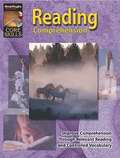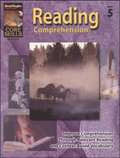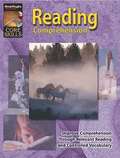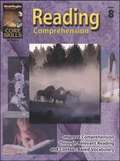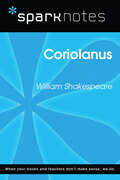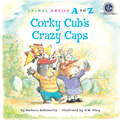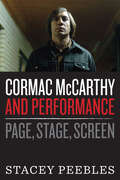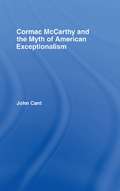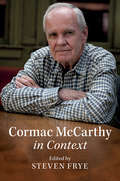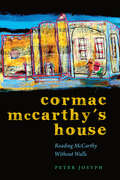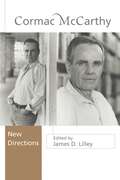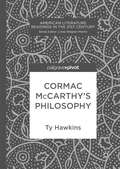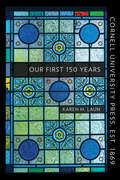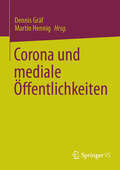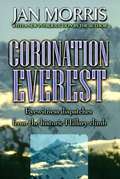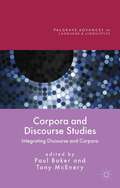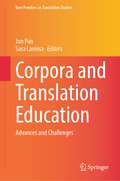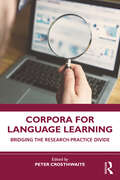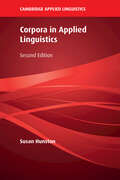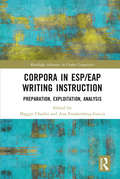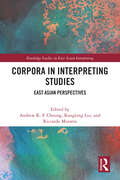- Table View
- List View
Core Skills: Reading Comprehension, Grade 4
by Steck-VaughnWelcome to the Steck-Vaughn Core Skills: Reading Comprehension series! You have selected a unique book that focuses on developing your child's comprehension skills, the reading and thinking processes associated with the printed word.
Core Skills: Reading Comprehension, Grade 5
by Steck-VaughnWelcome to the Steck-Vaughn Core Skills: Reading Comprehension series! You have selected a unique book that focuses on developing your child's comprehension skills, the reading and thinking processes associated with the printed word.
Core Skills: Reading Comprehension, Grade 6
by Steck-VaughnWelcome to the Steck-Vaughn Core Skills: Reading Comprehension series! You have selected a unique book that focuses on developing your child's comprehension skills, the reading and thinking processes associated with the printed word.
Core Skills: Reading Comprehension, Grade 7
by Steck-VaughnWelcome to the Steck-Vaughn Core Skills: Reading Comprehension series! You have selected a unique book that focuses on developing your child's comprehension skills, the reading and thinking processes associated with the printed word.
Core Skills: Reading Comprehension, Grade 8
by Steck-VaughnWelcome to the Steck-Vaughn Core Skills: Reading Comprehension series! You have selected a unique book that focuses on developing your child's comprehension skills, the reading and thinking processes associated with the printed word.
Coriolanus (SparkNotes Literature Guide Series)
by SparkNotesCoriolanus (SparkNotes Literature Guide) by William Shakespeare Making the reading experience fun! Created by Harvard students for students everywhere, SparkNotes is a new breed of study guide: smarter, better, faster.Geared to what today's students need to know, SparkNotes provides:chapter-by-chapter analysis explanations of key themes, motifs, and symbols a review quiz and essay topics Lively and accessible, these guides are perfect for late-night studying and writing papers.
Coriolanus: Critical Essays (Shakespearean Criticism)
by David WheelerOriginally published in 1995. Providing the most influential historical criticism, but also some contemporary pieces written for the volume, this collection includes the most essential study and reviews of this tragic play. The first part contains critical articles arranged chronologically while the second part presents reviews of stage performances from 1901 to 1988 from a variety of sources. Chapters chosen are representative of their given age and critical approach and therefore show the changing responses and the topics that interested critics in the play through the years. Coriolanus is an unsympathetic character and the play has been traditionally less popular than other tragedies - a comprehensive introduction by the editor discusses these attitudes to the play and the reasons behind them.
Corky Cub's Crazy Caps (Animal Antics A to Z)
by Barbara deRubertisGet to know Alpha Betty&’s class in the award-winning, 26-book alphabet series ANIMAL ANTICS A TO Z! From Alexander Anteater to Zachary Zebra, it&’s one adventure after another. Zip along with these zany characters as they find new friends, test their talents, and have a rip-roaring good time! Corky Cub's best chum is moving away! Who will play catch with him? Who will make cookies and crazy caps with him? Can Corky's classmates at Alpha Betty's school help solve his problem? This series is a perfect read-aloud choice to help kids discover the joy of letter sounds and give them the phonics building blocks they need for reading success. With delightful illustrations by Paddington Bear illustrator R.W. Alley, ANIMAL ANTICS A TO Z is an excellent resource for parents and educators alike. Activities in each book plus free activities online add to the fun. Winner: Teachers&’ Choice Award for Children&’s BooksWinner: Teachers&’ Choice Award for the Family
Cormac McCarthy and Performance: Page, Stage, Screen
by Stacey PeeblesCormac McCarthy is renowned as the author of popular and acclaimed novels such as Blood Meridian, All the Pretty Horses, and The Road. Throughout his career, however, McCarthy has also invested deeply in writing for film and theater, an engagement with other forms of storytelling that is often overlooked. He is the author of five screenplays and two plays, and he has been significantly involved with three of the seven film adaptations of his work. In this book, Stacey Peebles offers the first extensive overview of this relatively unknown aspect of McCarthy&’s writing life, including the ways in which other artists have interpreted his work for the stage and screen. Drawing on many primary sources in McCarthy&’s recently opened archive, as well as interviews, Peebles covers the 1977 televised film The Gardener&’s Son; McCarthy&’s unpublished screenplays from the 1980s that became the foundation for his Border Trilogy novels and No Country for Old Men; various successful and unsuccessful productions of his two plays; and all seven film adaptations of his work, including John Hillcoat&’s The Road (2009) and the Coen brothers&’ Oscar-winning No Country for Old Men (2007). Emerging from this narrative is the central importance of tragedy—the rich and varied portrayals of violence and suffering and the human responses to them—in all of McCarthy&’s work, but especially his writing for theater and film.
Cormac McCarthy and the Myth of American Exceptionalism (Studies in Major Literary Authors)
by John CantThis overview of McCarthy’s published work to date, including: the short stories he published as a student, his novels, stage play and TV film script, locates him as a icocolastic writer, engaged in deconstructing America’s vision of itself as a nation with an exceptionalist role in the world. Introductory chapters outline his personal background and the influences on his early years in Tennessee whilst each of his works is dealt with in a separate chapter listed in chronological order of publication.
Cormac McCarthy in Context (Literature in Context)
by Steven FryeCormac McCarthy is a writer informed by an intense curiosity. His interests range from the natural world, to philosophy and religion, to history and culture. Cormac McCarthy in Context offers readers the opportunity to understand how various influences inform his rich body of work. The collection explores the relationship McCarthy has with his favourite authors, writers such as Herman Melville, William Faulkner, and Ernest Hemingway. Other contexts are tremendously informative, including the American Romance tradition of the nineteenth century as well as modernity and the modernist literary movement. Influence and context are of absolute importance in understanding McCarthy, who is now being understood as one of the most significant authors of the contemporary period.
Cormac McCarthy's House: Reading McCarthy Without Walls (Southwestern Writers Collection Series, Wittliff Collections at Texas State University)
by Peter JosyphNovelist Cormac McCarthy's brilliant and challenging work demands deep engagement from his readers. In Cormac McCarthy's House, author, painter, photographer, and actor-director Peter Josyph draws on a wide range of experience to pose provocative, unexpected questions about McCarthy's work, how it is achieved, and how it is interpreted. As a visual artist, Josyph wrestles with the challenge of rendering McCarthy's former home in El Paso as a symbol of a great writer's workshop. As an actor and filmmaker, he analyzes the high art of Tommy Lee Jones in The Sunset Limited and No Country for Old Men. Invoking the recent suicide of a troubled friend, he grapples with the issue of "our brother's keeper" in The Crossing and The Sunset Limited. But for Josyph, reading the finest prose-poet of our day is a project into which he invites many voices, and his investigations include a talk with Mark Morrow about photographing McCarthy while he was writing Blood Meridian; an in-depth conversation with director Tom Cornford on the challenges of staging The Sunset Limited and The Stonemason; a walk through the streets, waterfronts, and hidden haunts of Suttree with McCarthy scholar and Knoxville resident Wesley Morgan; insights from the cast of The Gardener's Son about a controversial scene in that film; actress Miriam Colon's perspective on portraying the Duena Alfonsa opposite Matt Damon in All the Pretty Horses; and a harsh critique of Josyph's views on The Crossing by McCarthy scholar Marty Priola, which leads to a sometimes heated debate. Illustrated with thirty-one photographs, Josyph's unconventional journeys into the genius of Cormac McCarthy form a new, highly personal way of appreciating literary greatness. "
Cormac McCarthy's House: Reading McCarthy Without Walls (Southwestern Writers Collection Series, Wittliff Collections at Texas State University)
by Peter JosyphNovelist Cormac McCarthy’s brilliant and challenging work demands deep engagement from his readers. In Cormac McCarthy’s House, author, painter, photographer, and actor-director Peter Josyph draws on a wide range of experience to pose provocative, unexpected questions about McCarthy’s work, how it is achieved, and how it is interpreted. As a visual artist, Josyph wrestles with the challenge of rendering McCarthy’s former home in El Paso as a symbol of a great writer’s workshop. As an actor and filmmaker, he analyzes the high art of Tommy Lee Jones in The Sunset Limited and No Country for Old Men. Invoking the recent suicide of a troubled friend, he grapples with the issue of “our brother’s keeper” in The Crossing and The Sunset Limited. But for Josyph, reading the finest prose-poet of our day is a project into which he invites many voices, and his investigations include a talk with Mark Morrow about photographing McCarthy while he was writing Blood Meridian; an in-depth conversation with director Tom Cornford on the challenges of staging The Sunset Limited and The Stonemason; a walk through the streets, waterfronts, and hidden haunts of Suttree with McCarthy scholar and Knoxville resident Wesley Morgan; insights from the cast of The Gardener’s Son about a controversial scene in that film; actress Miriam Colon’s perspective on portraying the Dueña Alfonsa opposite Matt Damon in All the Pretty Horses; and a harsh critique of Josyph’s views on The Crossing by McCarthy scholar Marty Priola, which leads to a sometimes heated debate. Illustrated with thirty-one photographs, Josyph’s unconventional journeys into the genius of Cormac McCarthy form a new, highly personal way of appreciating literary greatness.
Cormac McCarthy: New Directions
by James D. LilleyEven before Harold Bloom designated Blood Meridian as the Great American Novel, Cormac McCarthy had attracted unprecedented attention as a novelist who is both serious and successful, a rare combination in recent American fiction. Critics have been quick to address McCarthy&’s indebtedness to southern literature, Christianity, and existential thought, but the essays in this collection are among the first to tackle such issues as gender and race in McCarthy&’s work. The rich complexity of the novels leaves room for a wide variety of interpretation. Some of the contributors see racist attitudes in McCarthy&’s views of Mexico, whereas others praise his depiction of U.S.-Mexican border culture and contact. Several of the essays approach McCarthy&’s work from the perspective of ecocriticism, focusing on his representations of the natural world and the relationships that his characters forge with their geographical environments. And by exploring the author&’s use of and attitudes toward language, some of the contributors examine McCarthy&’s complex and innovative storytelling techniques.
Cormac McCarthy’s Philosophy: On Truth, Justice, Will, And Grace In The Fiction (American Literature Readings in the 21st Century)
by Ty HawkinsThis study contends that American writer Cormac McCarthy not only is philosophical, or a "writer of ideas," but rather that he has a philosophy. Devoting one main chapter to each facet of McCarthy's thought - his metaphysics, epistemology, and ethics, respectively - the study engages in focused readings of all of McCarthy's major works. Along the way, the study brings McCarthy's ideas into conversation with a host of philosophers who range from Plato to Alain Badiou, with figures such as William James, Martin Heidegger, Hannah Arendt, and Slavoj Žižek featured prominently. Situated at the crossroads of literary studies, literary theory, cultural studies, continental philosophy, and theology, the appeal of Cormac McCarthy's Philosophy is widespread and deeply interdisciplinary.
Cornell University Press, Est. 1869: Our First 150 Years
by Karen M. LaunA history of the first 150 years of Cornell University Press.
Corona und mediale Öffentlichkeiten
by Martin Hennig Dennis GräfDieses Buch bietet einen umfassenden, interdisziplinären Blick auf mediale Erscheinungsformen im Kontext der Corona-Krise und fokussiert in diesem Zusammenhang insbesondere medien- und kommunikationswissenschaftliche, linguistische und philosophische Perspektiven auf die öffentliche Kommunikation zum Themenfeld des Coronavirus. Gerade zu Beginn der Corona-Krise kam es aufgrund der aus der Neuartigkeit des Coronavirus resultierenden Ungewissheit zu signifikanten kommunikativen Störmomenten, deren Rekapitulation und Analyse für eine demokratische Gesellschaft unabdingbar sind. In diesem Sinne forscht dieses Buch nach den kommunikativen Mustern des öffentlichen Sprechens über das Coronavirus in fiktionalen sowie nicht-fiktionalen Formaten.Konkret werden im Rahmen der nicht-fiktionalen Formate TV-Nachrichtensendungen, TV-Talkshows und TV-Dokumentationen, Printnachrichten sowie Social Media-Posts analysiert. Im Rahmen der fiktionalen Formate stehen v.a. Online-Serien im Fokus des Interesses. Die unterschiedlichen, sich aus der Interdisziplinarität des Bandes ergebenden methodischen Zugänge ermöglichen einen breit gefächerten, polyperspektivischen Zugang zur Corona-Kommunikation und lassen gleichwohl (medien-)übergreifende diskursive Muster - als ein signifikantes Ergebnis des Sammelbandes - erkennen.
Coronation Everest
by Jan MorrisMay 29, 1953: Edward Hillary and Tenzing Norgay first reach the summit of Mount Everest, and nearly the Coronation Day for a new Queen, Elizabeth II. Breaking the story was James Morris, special correspondent for The Times, who met the victorious climbers at Camp IV at 20,000 feet. Morris known to millions of readers today as the travel essayist Jan Morris, wrote this account of the Hillary expedition with all the verve and sharp detail for which Jan Morris is famous.
Corpora and Discourse Studies
by Tony Mcenery Paul BakerThe growing availability of large collections of language texts has expanded our horizons for language analysis, enabling the swift analysis of millions of words of data, aided by computational methods. This edited collection contains examples of such contemporary research which uses corpus linguistics to carry out discourse analysis. The book takes an inclusive view of the meaning of discourse, covering different text-types or modes of language, including discourse as both social practiceand as ideology or representation. Authors examine a range of spoken, written, multimodal and electronic corpora covering themes which include health, academic writing, social class, ethnicity, gender, television narrative, news, Early Modern English and political speech. The chapters showcase the variety of qualitative and quantitative tools and methods that this new generation of discourse analysts are combining together, offering a set of compelling models for future corpus-based research indiscourse.
Corpora and Translation Education: Advances and Challenges (New Frontiers in Translation Studies)
by Sara Laviosa Jun PanThis edited book covers a range of topics related to the use of corpora in translation education, including their standing in corpus-based translation studies, their relationship with machine learning and post-editing, recent advances in learner corpora development and the integration of corpora into translation pedagogy.The book draws the reader into the latest debate on the potential benefits and challenges of using corpora in translation education, as well as serving as practical guidance on how to incorporate corpora into their teaching practice.The book is of particular interest to translation educators, researchers, and postgraduate students who are interested in exploring theoretical underpinnings as well as new ways of teaching and learning translation.
Corpora for Language Learning: Bridging the Research-Practice Divide
by Peter CrosthwaiteThis volume presents a diverse range of expertise and practical advice on corpus-assisted language learning, bridging the gap between corpus research and actual classroom practice.Grounded in expert discussions and interviews, the book offers an extensive exploration into the intricacies of corpus-based language pedagogy, addressing its challenges, benefits, and potential drawbacks while demonstrating the power of data-driven learning (DDL) tools, including AntConc, WordSmith Tools, and CorpusMate. The book navigates the complexities of integrating DDL into mainstream educational systems, showcasing real-world applications for teaching. The authors bring together cutting-edge, international perspectives on this topic in dialogue with those using such techniques in their classroom practice.Both a rigorous academic resource and a hands-on guide for practitioners, this book is recommended reading for educators, researchers, or anyone wanting to upskill themselves in learning to harness the power of data in language pedagogy in primary, secondary, tertiary, or other professional contexts.
Corpora in Applied Linguistics (Cambridge Applied Linguistics)
by Susan HunstonCorpus Linguistics has revolutionised the world of language study and is an essential component of work in Applied Linguistics. This book, now in its second edition, provides a thorough introduction to all the key research issues in Corpus Linguistics, from the point of view of Applied Linguistics. The field has progressed a great deal since the first edition, so this edition has been completely rewritten to reflect these advances, whilst still maintaining the emphasis on hands-on corpus research of the first edition. It includes chapters on qualitative and quantitative research, applications in language teaching, discourse studies, and beyond. It also includes an extensive discussion of the place of Corpus Linguistics in linguistic theory, and provides numerous detailed examples of corpus studies throughout. Providing an accessible but thorough grounding to the fascinating, fast-moving field of Corpus Linguistics, this book is essential reading for the student and the researcher alike.
Corpora in ESP/EAP Writing Instruction: Preparation, Exploitation, Analysis (Routledge Advances in Corpus Linguistics)
by Maggie CharlesThis collection showcases the latest innovations in research on the application of corpora and corpus-based methods in ESP/EAP writing instruction and the many ways in which corpora can be successfully and practically integrated in ESP/EAP programmes. While previous work has discussed the successful use of corpora in teaching writing in the areas of ESP/EAP, this book is the first of its kind to bring the most up-to-date research on the topic together in one place. The volume’s unique structure mirrors the key stages of the writing instruction process, from preparation to exploitation to analysis. The book begins by showing how corpora can be used to prepare materials, moving into an exploration of how students in ESP/EAP programmes use corpora in practice, before bringing the discussion full circle to the ways in which corpus-based approaches might be implemented to analyse ESP/EAP student writing. This approach presents readers with insights into how corpora can be effectively integrated into ESP/EAP writing instruction at every step of the process and opens the way for future areas of study. This book will be of particular interest to students and researchers in applied corpus linguistics, English for Specific Purposes, and English for Academic Purposes, as well as active practitioners in ESP/EAP writing instruction.
Corpora in ESP/EAP Writing Instruction: Preparation, Exploitation, Analysis (Routledge Advances in Corpus Linguistics)
by Maggie CharlesThis collection showcases the latest innovations in research on the application of corpora and corpus-based methods in ESP/EAP writing instruction and the many ways in which corpora can be successfully and practically integrated in ESP/EAP programmes. While previous work has discussed the successful use of corpora in teaching writing in the areas of ESP/EAP, this book is the first of its kind to bring the most up-to-date research on the topic together in one place. The volume’s unique structure mirrors the key stages of the writing instruction process, from preparation to exploitation to analysis. The book begins by showing how corpora can be used to prepare materials, moving into an exploration of how students in ESP/EAP programmes use corpora in practice, before bringing the discussion full circle to the ways in which corpus-based approaches might be implemented to analyse ESP/EAP student writing. This approach presents readers with insights into how corpora can be effectively integrated into ESP/EAP writing instruction at every step of the process and opens the way for future areas of study.This book will be of particular interest to students and researchers in applied corpus linguistics, English for Specific Purposes, and English for Academic Purposes, as well as active practitioners in ESP/EAP writing instruction.
Corpora in Interpreting Studies: East Asian Perspectives (Routledge Studies in East Asian Interpreting)
by Cheung, Edited by Andrew K. FCheung, Liu, Moratto, and their contributors examine how corpora can be effectively harnessed to benefit interpreting practice and research in East Asian settings. In comparison to the achievements made in the field of corpus- based translation studies, the use of corpora in interpreting is not comparable in terms of scope, methods, and agenda. One of the predicaments that hampers this line of inquiry is the lack of systematic corpora to document spoken language. This issue is even more pronounced when dealing with East Asian languages such as Chinese, Japanese, and Korean, which are typologically different from European languages. As language plays a pivotal role in interpreting research, the use of corpora in interpreting within East Asian contexts has its own distinct characteristics as well as methodological constraints and concerns. However, it also generates new insights and findings that can significantly advance this research field. A valuable resource for scholars of scholars focusing on corpus interpreting, particularly those dealing with East Asian languages.
